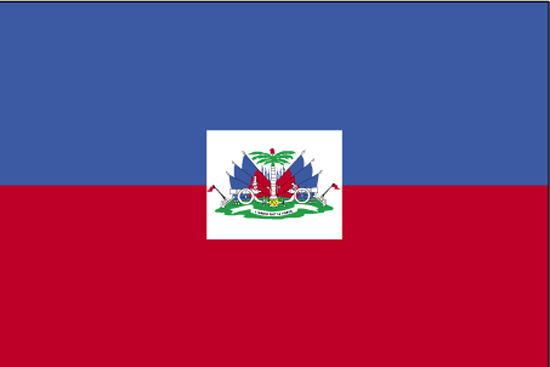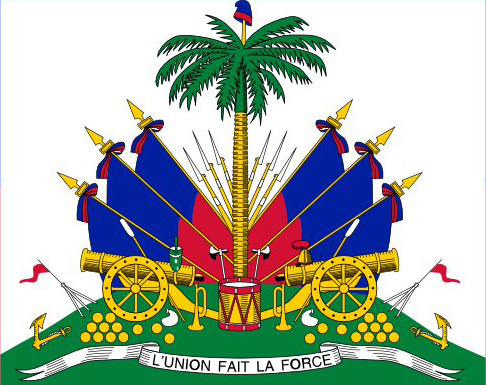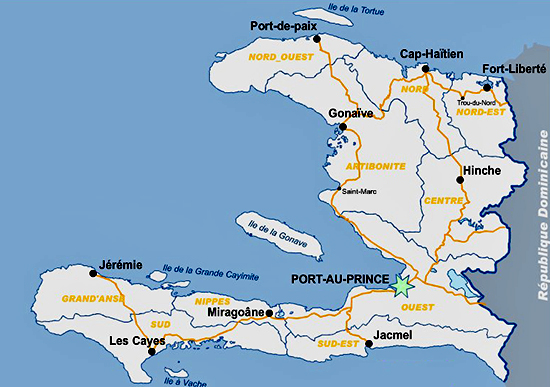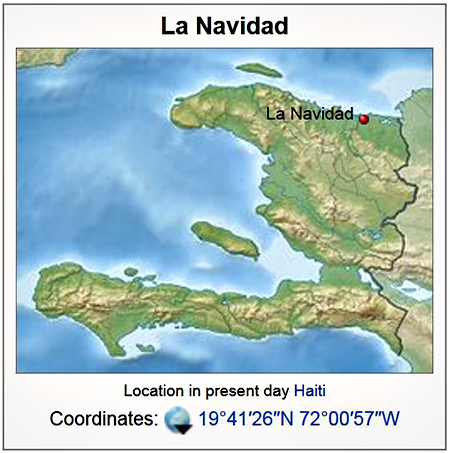|

Flag of Haiti
Haiti
|
|
Image Above
Flag description:
two equal horizontal bands of blue (top) and red
with a centered white rectangle bearing the coat
of arms, which contains a palm tree flanked by
flags and two cannons above a scroll bearing the
motto L'UNION FAIT LA FORCE (Union Makes
Strength); the colors are taken from the French
Tricolor and represent the union of blacks and
mulattoes
CIA.gov |
Here is the middle bit enlarged:

L'Union Fait La Force - Union Makes Strength
Today's Republic of Haiti is a
country in the Caribbean.
Haiti's official languages are French and Creole.
Haiti shares the island
Hispaniola
with the Dominican Republic.
Here is the map:

Haiti 1999
Click to enlarge
And here is another map:

Map of Haiti
Haiti Department of Tourism
History of Haiti
Among the ancient tribes of Haiti we
had the Arawak, the
Taino, and the
Ciboney.
As part of his first voyage,
 Christopher Columbus
arrived on the island on December 6, 1492. The Taino called it Ayti
(Haiti) and it was also known as Quisqueya. But Columbus renamed it
La Isla Espaņola, which became
Hispaniola.
Christopher Columbus
arrived on the island on December 6, 1492. The Taino called it Ayti
(Haiti) and it was also known as Quisqueya. But Columbus renamed it
La Isla Espaņola, which became
Hispaniola.
Columbus set up the first European
settlement in the New World and called it La Navidad (Christmas.)
Here is an excerpt from a New York
Times article by John Noble Wilford, published August 27, 1985:
On the night before Christmas in 1492, the
flagship of Christopher Columbus, the
Santa Maria, ran aground on a reef off
the North Coast of Hispaniola and was
wrecked beyond repair. Accepting the
hospitality of an Arawak chief, the men
stripped timbers from the abandoned ship and
erected a fortified settlement at an Indian
town. Columbus named the place La Navidad.
Leaving 39 men there with instructions to
trade for gold, Columbus sailed back to
Spain on the Nina. He returned 11
months later to find a scene of desolation.
Both the European settlement and the
surrounding Indian village had been burned.
All of his men were dead.
Columbus sailed on, and La Navidad dropped
out of sight. The location and fate of this
first European settlement in the New World -
the point of first extended contact between
European and New World cultures - have
mystified scholars ever since.
 Here you can read the entire article.
Here you can read the entire article.
And here is La Navidad on a map:

Map Location La
Navidad, in today's Haiti
Wiki
Thus, Spain became Haiti's first
European sovereign. But they kept themselves mainly on the eastern
part of the island (today's Dominican Republic), while French
settlements appeared on the western part of the island (today's
Haiti).
By the
Treaty of Rijswijk, the French became masters over
Haiti in 1697. They called it Saint-Domingue.
Haiti's indigenous people disappeared while slaves were brought in
from Africa.
But Haiti lit up with a bang in the process.
In 1789, Saint Domingue had an
estimated population of 556,000, including roughly 500,000 African
slaves, 32,000 European colonists, and 24,000 free mulattoes.
This played an important role in the
 Mulatto Revolt.
Mulatto Revolt.
The
 Haitian Revolution, also
called the Santo Domingo Slave Revolt, was fought from 1791-1804.
Haitian Revolution, also
called the Santo Domingo Slave Revolt, was fought from 1791-1804.
In 1804, Haiti gained independence
from the French, thus becoming the first independent black republic.
More History
|